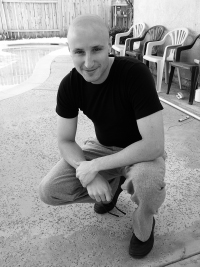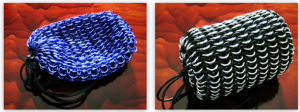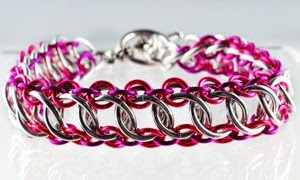Part of what we love about chainmaille — beyond actually weaving, of course — is getting to know and learn from other fun, creative and talented maillers. With this in mind, we are especially excited to announce that guest instructor Joshua Diliberto will soon be teaching a class at Blue Buddha Boutique!
 Joshua will be on hand Saturday, May 3, to explain how to weave a chainamille bag – the first step when learning how to weave chainmaille clothing. Actually weaving will be just the surface of this class – he’ll also discuss the “flat expanding round” pattern, an essential technique to know if you’re looking to make projects such as coifs, cozies, bikini tops, shirts and other projects.
Joshua will be on hand Saturday, May 3, to explain how to weave a chainamille bag – the first step when learning how to weave chainmaille clothing. Actually weaving will be just the surface of this class – he’ll also discuss the “flat expanding round” pattern, an essential technique to know if you’re looking to make projects such as coifs, cozies, bikini tops, shirts and other projects.

Joshua has been making chainmaille for nearly 20 years and considers himself lucky to weave for a living. His specialty is creating new chainmaille weaves and applications; to date, he has 56 original weaves documented in the Maille Artisans International League (MAIL) database.
We spoke with him about his creative process and how he develops new weaves. Joshua said, “Creating a new weave can come from many different places, and it often comes from a place inside that is never expected. Sometimes a new weave can come from a mistake. Sometimes it comes from playing around or experimenting. Sometimes a new weave is born from problem solving – maybe a bracelet needs to bend in a different direction and a new connection is explored. Coming up with a new weave is like publishing a scientific article or a piece of poetry. Chainmaille can be a beautifully rich artistic expression and it can also be a deep field of theory and research. Chainmaille weaves are my love.”
Developing a new weave isn’t the only challenging part. Before it can be registered, an artist must exercise due diligence and check to see if the weave they’ve created already exists! With more than 1300 weaves in the MAIL database, this is an arduous task, but a necessary one. Joshua advises artists, “The good news is that it looks like there are an infinite number of weaves to be made, so don’t be discouraged. It’s always important to make sure a new weave is useful or practical in some way. I’ve probably thrown away more new weaves than I’ve published because they aren’t pretty to me or have no use. If a new weave is just a jumble of rings that don’t interact well together, I will usually toss the weave in my mistake pile.”
Wait – a mistake pile? Yes. Joshua continued with, “My number one piece of advice to chainmaillers is to keep all of your mistakes. Do not take apart mistakes or throw them away because we are destined to repeat our mistakes. To me, a mistake is a temporary sacrifice that results in a future gain in experience and knowledge. Creations wouldn’t be so interesting if they always came out the way we expect.”
He summarized his process for coming up with new weaves as this: “I’ll try to make 20 new weaves. Out of those, 10 of them will be possible, and out of those, five of them will be useful. And out of those, one of them will be beautiful.”
Seats are filling quickly, so don’t delay. Register now for Joshua’s class at B3 in Chicago on May 3.

